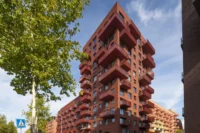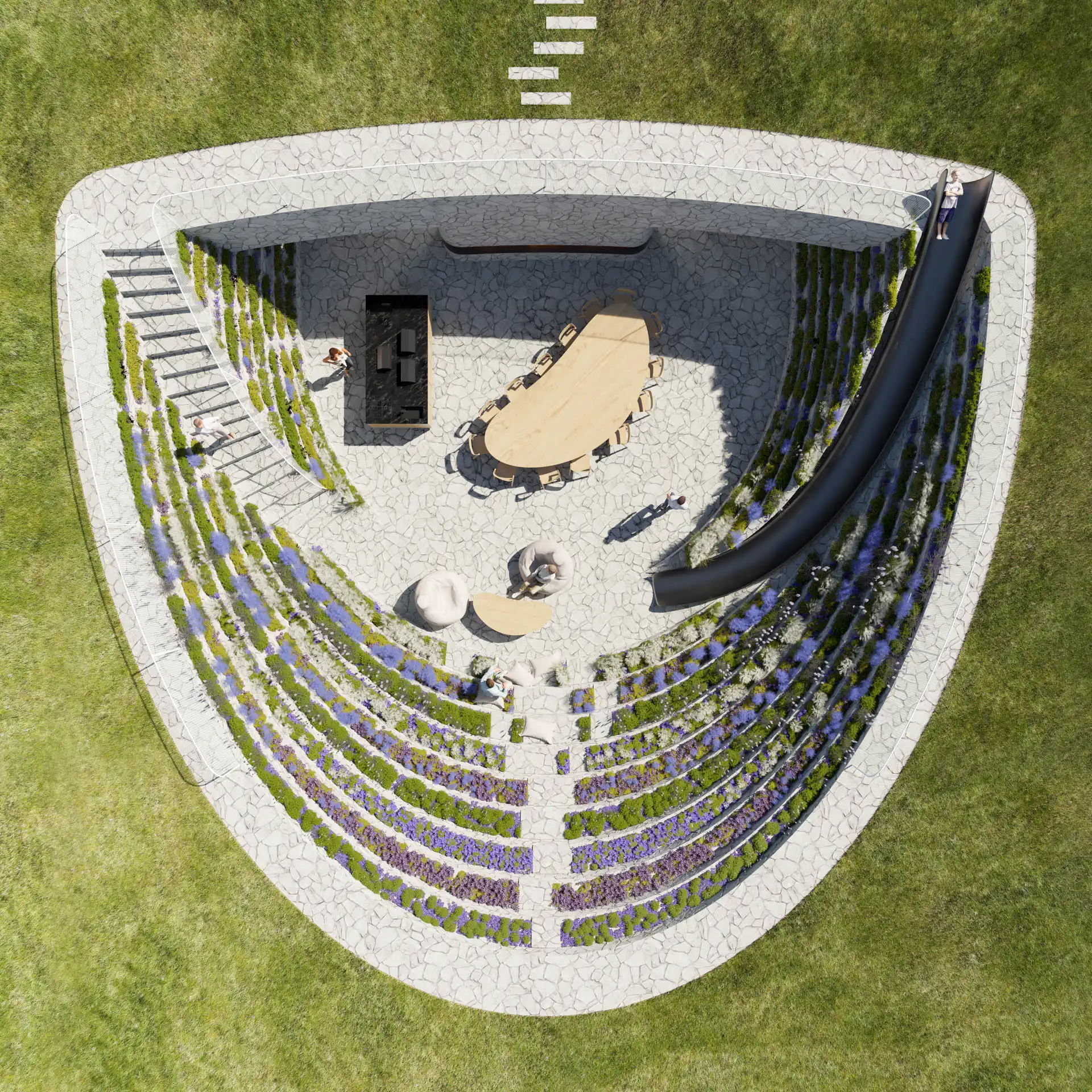Architecture:E Plus Design and URBANUS/LXD Studio
Area: 80,882 m²
Year: 2023
Location: Conghua, Guangzhou
Over the past three decades, developers across China have constructed numerous faux-European commercial complexes, replicating the European outlet model. As the era of commercial boom gradually fades, these “pseudo-European” developments have not only lost their appeal but now face immense pressure to transform.
In response to this type of urban renewal challenge, the project has taken an unconventional approach—leveraging color as a transformative tool. What was once a lifeless faux-European complex has been reborn as a vibrant urban landmark, creating a fresh micro-vacation destination in northern Guangzhou.

#01
From faux-European “ghost town” to thriving new outlet destination: “light renovation” revives vitality
Originally completed in 2018, the 110,000-square-meter Euro-style outlet town in Conghua, Guangzhou had remained idle for years due to various circumstances, awaiting a new lease on life.
The design team employed a light-intervention, low-cost strategy to redefine the spatial identity—replacing intricate ornamentation with a low-saturation color palette to create a visual language that blends youthfulness, vibrancy, and fashion. Through incorporating rhythms and cadence, the team reimagined the original facades, crafting an environment where nature meets luxury to captivate micro-vacation seekers.
By harmonizing commercial logic, spatial form, visual identity, and cultural narrative, the renovation achieved a holistic reintegration and organic renewal—reviving a massive, long-abandoned megastructure into a dynamic urban node.
The innovative business model of micro-vacation outlet complex made it an instant phenomenon upon opening, soon becoming a trending hotspot. In just nine days, it attracted over 500,000 visitors, and over 60000 vehicles. It topped Dianping’s Guangzhou destination rankings for four consecutive days. Across online media platforms, it amassed 50 million total engagements, including 20 million interactions on Douyin, 15 million hashtag discussions on Xiaohongshu, and more than 20,000 saves and reviews on Dianping.
This color-driven, light-touch renovation challenges the entrenched notion that pseudo-European commercial properties are doomed to obsolescence. More importantly, backed by solid data, it demonstrates that reconnecting design with its local context can unleash remarkable, unexpected market potential for long-idle properties.

#02
A Contemporary Remix of Classical Music: Streets as Movements, Colors as Notes
“This approach is like a contemporary remix of classical music. The four blocks correspond to four movements. Without extensive demolition or altering the European-style architectural rhythm, we reinterpreted the emotional tones, chords, and cadenzas. Through a blend of color and modern gestures, the outdated and disproportionate ‘faux-antique’ complex has been reorchestrated into a contemporary architectural symphony.”
— Li Fu, Chief Architect, E Plus Design
Inspired by music, the design reinterprets the original buildings as a classical piece remixed through modern aesthetics. Each of the four blocks becomes a movement in this visual symphony: the street facades as a “Golden Variation,” the sports block as a “Blue Variation,” the newly constructed volumes as a “Transparent Variation,” and the central plaza as a “Roman Rhapsody.”
The initial and most direct modification involves painting all existing building facades in soft tones, removing the clutter of mixed colors and textures. This reveals the underlying spatial rhythm of the architectural structures—much like a steady background beat in music.
The renovated street facades present a striking new urban frontage along the metro line and expressway. A golden “gift box ribbon” weaves through the grand facades, creating a striking contrast between old and new architectural volumes, extending seamlessly from the entrance canopy to the central axis.
At the heart of the design lies the elliptical central plaza—a key junction where above-ground and underground pedestrians converge. This space called for a visual spectacle, an iconic public landscape.
Inspired by ancient Roman aqueducts, the design introduces a cascading structure that appears to “collapse” at the middle, where water streams down onto the “ruins,” transforming into a dramatic waterfall.
“This aqueduct will become the iconic centerpiece of the entire outlet town—an unforgettable symbol etched into visitors’ memories. A commercial project needs a memorable landmark—something people instantly associate with the place, just like the Arc de Triomphe or Eiffel Tower in Paris.”
— Liu Xiaodu, Architect of the Central Plaza, Chief Design Consultant

#03
Water as the thread: a new ecological landscape
Natural engagement and emotional connection
Rooted in the water culture of the nearby Liuxi River, water becomes the central element of landscape design. By integrating interactive experiences such as “enjoying water,” “observing water,” and “engaging with water,” the design fosters a playful and ecologically vibrant environment.
Through various forms and carefully selected materials, the design introduces a series of interactive water-themed landscape nodes, including artificial streams, fountains, and sculptural water features. These elements enhance the natural ambiance while offering visitors a multi-sensory experience, enriching both interaction and enjoyment.
Wherever permitted by fire lane regulations, greenery is maximized—particularly at the entrance plaza, the central axis, and the circular corridors—to create a vibrant and nature-filled atmosphere. Indigenous plant species are carefully selected to ensure year-round greenery and seasonal beauty, balancing ecological sensitivity with aesthetic appeal.
“This project exemplifies the synergy of architectural and landscape design in creating meaningful value, in line with our core design philosophy—practicability, playfulness, and aesthetics. Based on the ‘micro-vacation’ concept, the landscape design is centered around the “Liuxi River” theme, fostering an environment where nature and human activity coexist harmoniously, with a focus on interaction and immersive ecological experiences.”
— Gao Yan, Chief Landscape Architect

#04
A unique urban micro-vacation destination,
where landscape and architecture seamlessly intertwine
The project incorporates elements of Liuxi River, making full use of the surrounding natural landscape while offering high-quality commercial services of the metropolitan . It has established a micro-vacation ecosystem, where visitors can enjoy budget-friendly shopping, outdoor leisure, and untamed natural charm. With engaging experiences for both children and adults, it truly brings the joy of vacation to life.
It represents a new trend of destinations rooted in natural scenery or cultural landscape, offering a blend of light tourism, immersive outdoor experiences, and premium urban commercial services—emerging as a favored leisure option for modern city residents.
“This outlet has something special.” Once a deserted faux-antique development, it has been revitalized through operation enrichment and eclectic reinterpretation, transforming into a distinctive urban micro-vacation destination.
This project showcases a pragmatic yet compelling approach for commercial complex revitalization in the era of urban renewal and building stock, offering a successful and inspiring model.
































Leave a comment